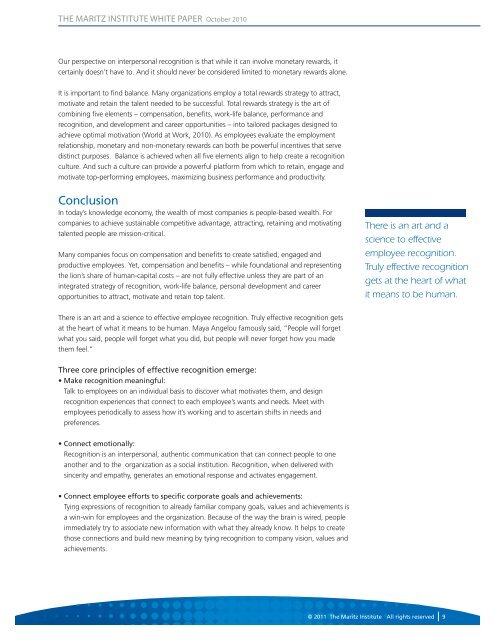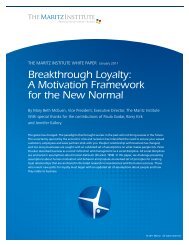The Human Science of Giving Recognition ... - Maritz Institute
The Human Science of Giving Recognition ... - Maritz Institute
The Human Science of Giving Recognition ... - Maritz Institute
Create successful ePaper yourself
Turn your PDF publications into a flip-book with our unique Google optimized e-Paper software.
THE MARITZ INSTITUTE WHITE PAPER October 2010<br />
Our perspective on interpersonal recognition is that while it can involve monetary rewards, it<br />
certainly doesn’t have to. And it should never be considered limited to monetary rewards alone.<br />
It is important to find balance. Many organizations employ a total rewards strategy to attract,<br />
motivate and retain the talent needed to be successful. Total rewards strategy is the art <strong>of</strong><br />
combining five elements – compensation, benefits, work-life balance, performance and<br />
recognition, and development and career opportunities – into tailored packages designed to<br />
achieve optimal motivation (World at Work, 2010). As employees evaluate the employment<br />
relationship, monetary and non-monetary rewards can both be powerful incentives that serve<br />
distinct purposes. Balance is achieved when all five elements align to help create a recognition<br />
culture. And such a culture can provide a powerful platform from which to retain, engage and<br />
motivate top-performing employees, maximizing business performance and productivity.<br />
Conclusion<br />
In today’s knowledge economy, the wealth <strong>of</strong> most companies is people-based wealth. For<br />
companies to achieve sustainable competitive advantage, attracting, retaining and motivating<br />
talented people are mission-critical.<br />
Many companies focus on compensation and benefits to create satisfied, engaged and<br />
productive employees. Yet, compensation and benefits – while foundational and representing<br />
the lion’s share <strong>of</strong> human-capital costs – are not fully effective unless they are part <strong>of</strong> an<br />
integrated strategy <strong>of</strong> recognition, work-life balance, personal development and career<br />
opportunities to attract, motivate and retain top talent.<br />
<strong>The</strong>re is an art and a science to effective employee recognition. Truly effective recognition gets<br />
at the heart <strong>of</strong> what it means to be human. Maya Angelou famously said, “People will forget<br />
what you said, people will forget what you did, but people will never forget how you made<br />
them feel.”<br />
Three core principles <strong>of</strong> effective recognition emerge:<br />
• Make recognition meaningful:<br />
Talk to employees on an individual basis to discover what motivates them, and design<br />
recognition experiences that connect to each employee’s wants and needs. Meet with<br />
employees periodically to assess how it’s working and to ascertain shifts in needs and<br />
preferences.<br />
• Connect emotionally:<br />
<strong>Recognition</strong> is an interpersonal, authentic communication that can connect people to one<br />
another and to the organization as a social institution. <strong>Recognition</strong>, when delivered with<br />
sincerity and empathy, generates an emotional response and activates engagement.<br />
• Connect employee efforts to specific corporate goals and achievements:<br />
Tying expressions <strong>of</strong> recognition to already familiar company goals, values and achievements is<br />
a win-win for employees and the organization. Because <strong>of</strong> the way the brain is wired, people<br />
immediately try to associate new information with what they already know. It helps to create<br />
those connections and build new meaning by tying recognition to company vision, values and<br />
achievements.<br />
<strong>The</strong>re is an art and a<br />
science to effective<br />
employee recognition.<br />
Truly effective recognition<br />
gets at the heart <strong>of</strong> what<br />
it means to be human.<br />
© 2011 <strong>The</strong> <strong>Maritz</strong> <strong>Institute</strong> All rights reserved 9



